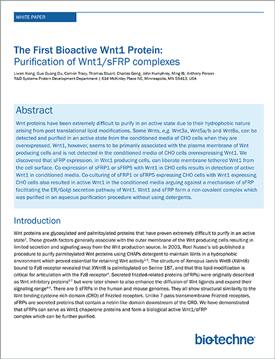While scientists have been able to detect and purify some Wnt proteins (e.g. Wnt3a, Wnt5a/b and Wnt8a) in an active state from conditioned media of CHO cells that overexpress a specific Wnt protein, purification of Wnt1 has been a challenge due to plasma membrane tethering. In this white paper, the protein development department at R&D Systems presents their method of detergent-free purification of Wnt1/sFRP complexes, which now allows R&D Systems to offer the first commercially available, bioactive Wnt1 protein for research use.
Bioactive Wnt1 protein is now available!
The Wnt signaling pathway contributes to such developmental decisions as cell fate determination, cell polarity, development of neoplasia, tissue patterning, and control of cell proliferation. These processes are necessary for embryonic development as well as development of tissues including heart, muscle, and bone.
Learn More about Available Bioactive Wnt1 protein
For more information on Wnt family proteins, explore our other Wnt-related resources:
Wnt Family Research Area
Learn more about the Wnt family and Wnt signaling by exploring information and products related to Wnt ligands, Wnt receptors, Wnt inhibitors, molecules involved in Wnt signaling, and Wnt signaling modulators.
Products for Wnt Research Brochure
Discover the proteins, antibodies, immunoassays, and small molecules that we offer to accelerate your Wnt research. From the most extensive offering of recombinant Wnt proteins to small molecule Wnt signaling inhibitors, we have the products that you need to understand the functions of different Wnt proteins and the signaling pathways that they activate.
Wnt Proteins in Intestinal Epithelial Progenitor Cells Scientific Poster
Read about the effects of different Wnt proteins, including Wnt-3a, Wnt-5a, Wnt-5b, Wnt-7a, and Wnt-10b, on small intestinal epithelial cells in this scientific poster. Learn more about the downstream signaling pathways that are activated by different Wnts and how these pathways are affected by specific Wnt inhibitors.
Beta-Catenin-dependent Wnt Signaling Pathways
Explore the different molecules that mediate the beta-Catenin-dependent Wnt signaling pathway and how R-Spondin proteins and antagonists of Wnt or LRP-5/6 affect this pathway.
Wnt/Ca2+ Signaling Pathways
Learn more about the beta-Catenin-independent Wnt/Ca2+ signaling pathway and the molecules downstream of the Wnt/Frizzled, Wnt/Ryk, or Wnt/ROR1/2 ligand-receptor complexes that mediate cell fate and cell migration.
Wnt/PCP Signaling Pathways
Explore the beta-Catenin-independent Wnt planar cell polarity (PCP) pathway and learn more about the different co-receptors that Wnt proteins can utilize and the downstream molecules that regulate cell motility and tissue polarity.
